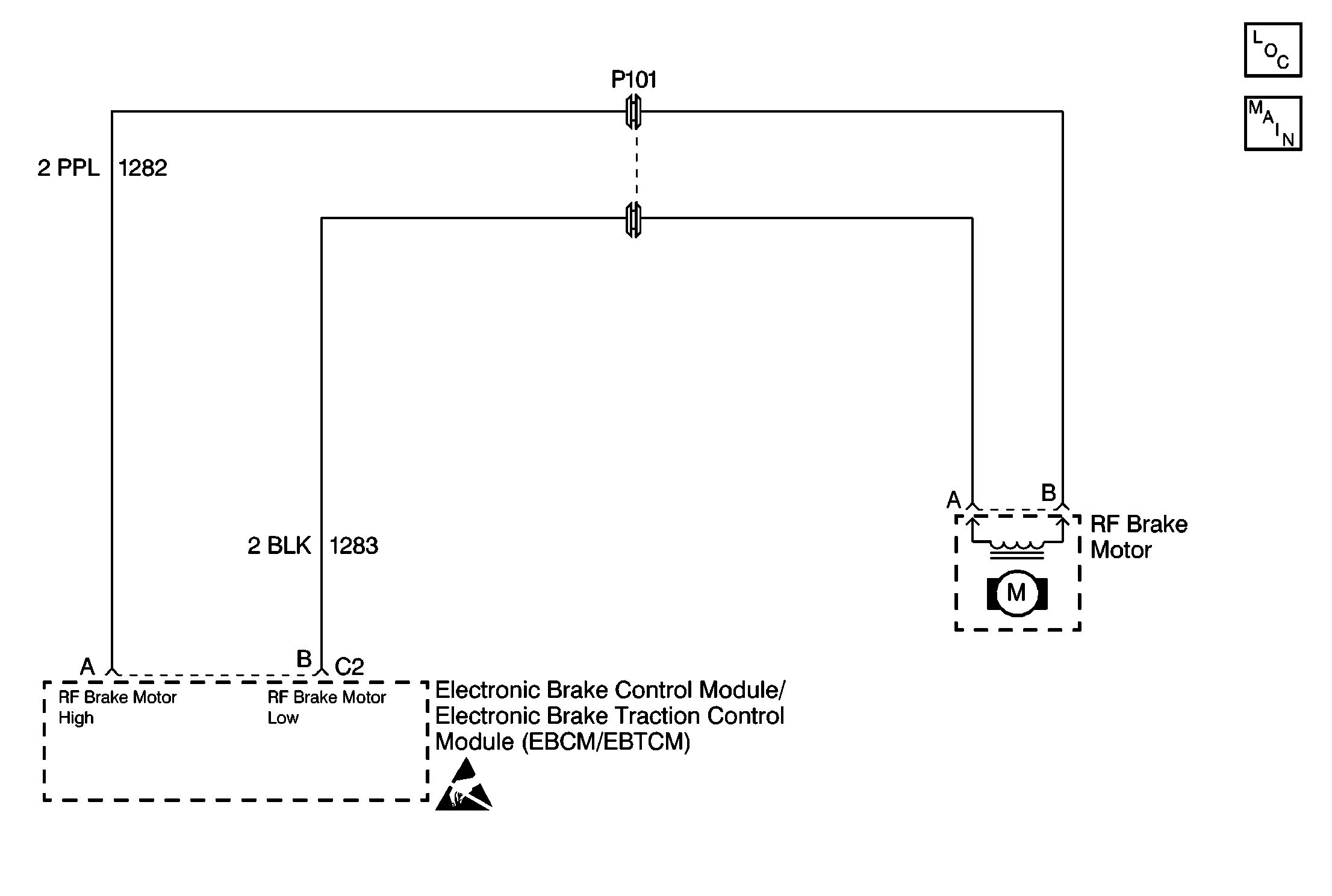
Circuit Description
DTC 1263 identifies an ABS motor circuit that is shorted shorts to voltage or an ABS motor that has low or no resistance. The malfunction will cause one of the following conditions to occur:
| • | The ABS motor will not be controlled at the commanded current rate. |
| • | The ABS motor will turn in the opposite direction or not at all. |
Conditions for Setting the DTC
DTC C1263 can set only when the ABS motor is commanded off.
A malfunction exists if the EBCTM detects an out of range voltage on either of the right front ABS motor circuits.
An out of range voltage on either circuit indicates one of the following conditions:
| • | A circuit shorts to voltage. |
| • | An ABS brake motor shorts internally. |
Action Taken When the DTC Sets
| • | A malfunction DTC stores. |
| • | The ABS/ETS disables. |
| • | The amber ABS/ETS warning indicators turn on. |
Conditions for Clearing the DTC
| • | The condition responsible for setting the DTC no longer exists and the Scan Tool Clear DTCs function is used. |
| • | 100 drive cycles pass with no DTCs detected. |
Diagnostic Aids
Use the Scan Tool Manual Control function in order to exercise ABS motor movement of affected channel in both directions while applying light pressure on the brake pedal. An intermittent malfunction may be indicated if erratic or jumpy brake pedal movement is detected while performing an apply or release function of the ABS monitor.
If the malfunction is not current, use wiggle test on the wiring harness to pinpoint an intermittent malfunction in the motor circuitry or connections. Thoroughly inspect any circuitry that may be causing the intermittent complaint for the following conditions:
| • | Backed out terminals |
| • | Improper mating |
| • | Improperly formed or damaged terminals |
| • | Poor terminal-to-wiring connections |
| • | Physical damage to the wiring harness |
| • | Rubbed-through wire insulation |
| • | A broken wire inside the insulation |
Clear the DTCs after completing the diagnosis. Test drive the vehicle for three drive cycles in order to verify that the DTC does not reset. Use the following procedure in order to complete one drive cycle:
- Start the vehicle.
- Drive the vehicle over 16 km/h (10 mph).
- Stop the vehicle.
- Turn the ignition to the OFF position.
Step | Action | Value(s) | Yes | No | ||||||||||||
|---|---|---|---|---|---|---|---|---|---|---|---|---|---|---|---|---|
1 | Was the Diagnostic System Check performed? | -- | ||||||||||||||
2 | Install a scan tool. Does DTC C1263 occur intermittently? | -- | Go to Diagnostic Aids | |||||||||||||
3 |
Do not start the engine. Is the voltage within the specified range? | 0-1 V | ||||||||||||||
4 | Use the J 39200 in order to measure the voltage between the 6-way ABS brake motor pack harness connector terminal A and ground. Is the voltage within the specified range? | 0-1 V | ||||||||||||||
5 |
Is the resistance within the specified range? | OL (Infinite) | ||||||||||||||
6 | Use the J 39200 in order to measure the resistance between the 6-way ABS motor pack connector terminal B and the 6-way ABS motor pack connector terminal A. Is the resistance measured within the specified range? | 0.2-1.5 ohms | ||||||||||||||
7 |
Is there damage which may cause a short to voltage? | -- | ||||||||||||||
8 |
Did DTC C1263 set as a current DTC during the last three drive cycles? | -- | ||||||||||||||
9 | Replace the ABS motor pack. Refer to ABS Motor Pack Replacement . Is the repair complete? | -- | -- | |||||||||||||
10 | Repair the short to voltage in CKT 1282. Is the repair complete? | -- | -- | |||||||||||||
11 | Repair the short to voltage in CKT 1283. Is the repair complete? | -- | -- | |||||||||||||
12 | Repair the short between CKT 1282 and CKT 1283. Is the repair complete? | -- | -- | |||||||||||||
13 | Replace all of the following components that are damaged:
Is the repair complete? | -- | -- | |||||||||||||
14 | Replace the EBTCM. Refer to Electronic Brake and Traction Control Module Replacement . Is the repair complete? | -- | -- | |||||||||||||
15 | Is the malfunction intermittent or is not present at this time? | -- | Go to Diagnostic Aids | -- |
